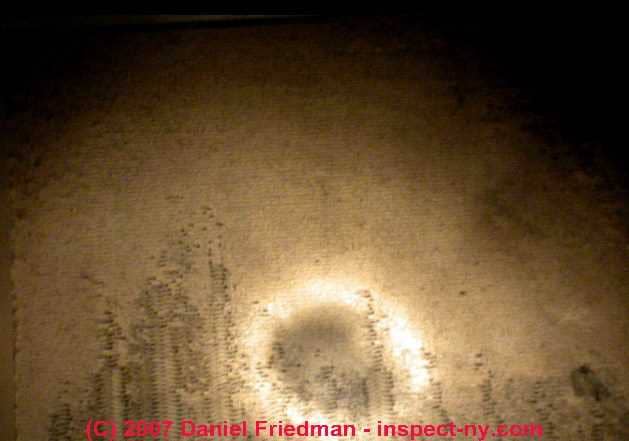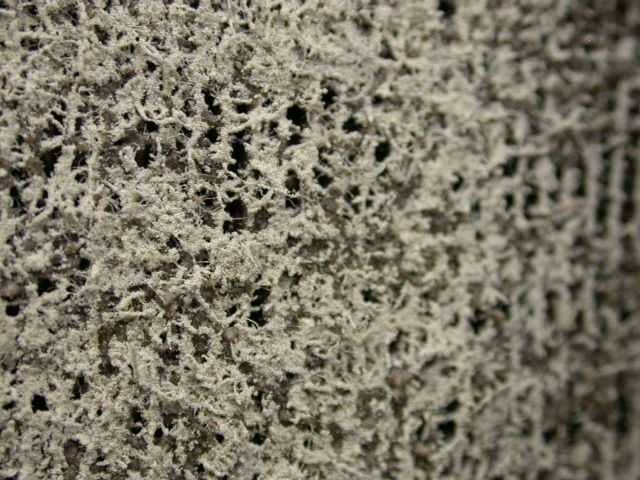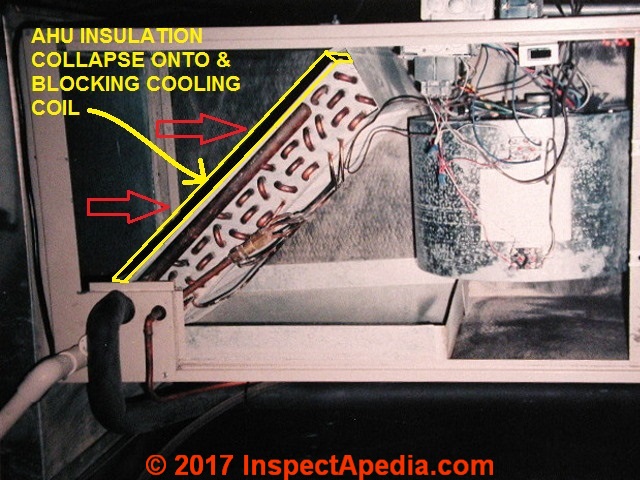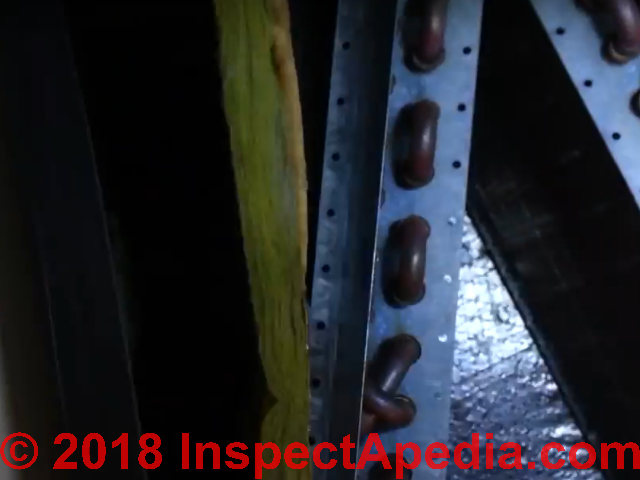 Air Conditioning & Heat Pump Air Handler Cooling Coil Blockage
Air Conditioning & Heat Pump Air Handler Cooling Coil Blockage
- POST a QUESTION or COMMENT about blocked, damaged, dirty A/C or heat pump cooling coils/evaporator coils
Cooling coil blockage by debris, damage, or ice - diagnosis & repair:
This air conditioning repair article discusses the problem of dirt or debris blockage of the air conditioning system's cooling coil or evaporator coil in an air conditioning system air handler, how the dirt gets there, what problems it causes, how to clean a cooling coil (or evaporator coil), and how to prevent future dirt on the coil.
InspectAPedia tolerates no conflicts of interest. We have no relationship with advertisers, products, or services discussed at this website.
- Daniel Friedman, Publisher/Editor/Author - See WHO ARE WE?
Blocked Cooling Coil: Air Conditioner Evaporator Coil Blocked by Debris

This photograph shows how easily debris can stick to and clog the inlet side of the cooling coil in an air conditioning system. This evaporator coil was nearly totally blocked with dust and debris. How does this happen?
[Click to enlarge any image]
There was no air filter installed in the system. Ordinary house dust is comprised largely of fabric fibers and skin cells.
These and other debris in building dust such as soot and organic particles like pollen and mold spores all join to form a gray mat on the fins of the cooling coil in an air handler.
Debris sticks particularly quickly to this surface because of the combination of close spacing of the cooling fins (about 1/16" apart) and the fact that condensate forming on the coil keeps the surface damp.
For A/C or heat pump cooling coil blockage problems, also
see DIRTY HVAC COIL CLEANING PROCEDURES
and FROST BUILD-UP on AIR CONDITIONER COILS .
If your air conditioning or heat pump system has lost its cooling capacity or won't start
see REPAIR GUIDE for AIR CONDITIONERS.
See COOLING CAPACITY, RATED of air conditioning equipment if the system seems to be working but is inadequate to cool your building.

Here is a close up photograph showing how fibers in building dust readily cross the blades of the cooling coil and how the fibers themselves then collect smaller particles to rapidly block air flow across the coil.
The same principles that make an air filter work can also clog the cooling coil of an air conditioning system.
As a cooling coil (or evaporator coil) in an air conditioner becomes blocked with dust and debris the air flow across the coil is reduced.
This reduced air flow (in cubic feet per minute or CFM) across the coil means that the cooling capability of the whole air conditioning system is reduced.
How do we clean a dirty air conditioner or heat pump cooling coil or evaporator coil?
See DIRTY HVAC COIL CLEANING PROCEDURES.
Other Causes of a Blocked Air Conditioning Evaporator Coil or Reduced Air-flow Across the Coil
Dirty air filter: can be mistaken for a blocked cooling coil. Always check your air filter first. Replace it if it's clogged and dirty and check the filter regularly.
See AIR HANDLER / BLOWER UNITS
Air filter wrong way: depending on its location, an air filter installed "wrong way", that is its arrow is not pointing in the direction of air flow but rather against that direction can cause air filter materials to actually tear out of the filter and then to be drawn against the cooling coil, blocking it and causing coil clogging and cooling coil icing.
This problem happens if the air filter is located between the blower and the cooling coil and is installed facing the wrong way.
See more at AIR FILTER LOCATION where we also discuss which way the air filter must face.
Watch out: for an air filter installed ahead of the blower fan, installing the filter the wrong way or installing a filter of the wrong size can cause the filter to be drawn into the blower fan, leading to overheating and even a fire.
Install the air filter so that it is it is seated properly, not bent or damaged, and facing with the arrows on the filter edges matching the direction of air flow through the filter.
Air Conditioner Evaporator Coil Frost or Ice Formation: When the coil becomes sufficiently blocked with debris as to slow down the air flow enough, the coil may actually become so cold that the condensate forming on its surface freezes, completely blocking the coil.
That's because the rate of release of refrigerant into the evaporator coil was designed with an assumption of a sufficient volume of air moving across the coil to keep it from becoming too cold.
When the surface temperature of an air conditioning
cooling coil drops below 32 deg F or 0 deg C, condensate forming on the coil surface begins to freeze, leading to sometimes some pretty weird behavior of the cooling system as we discuss
at FROST BUILD-UP on AIR CONDITIONER COILS where we explain that there can be more than one reason that a cooling coil ices-up but none of those conditions is desirable.
Air leaks or unnoticed duct openings: in the duct system can interfere with proper airflow through the duct system, reducing air delivery into the building, and can be mistaken for a blocked or dirty cooling coil.
Details are at DUCT SYSTEM DESIGN SIZE & DEFECTS.
Damaged air conditioner coil fins: can occur on both the evaporator (cooling) coil and the outside condensing coil.
See CONDENSING COIL REPAIR REPLACE for discussion of repairing bent or damaged coil fins. Only in extreme cases will fin damage be so severe that air flow across the cooling coil is severely blocked - enough to cause loss of function or coil icing.
Dirty air handler blower fan:
see AIR HANDLER / BLOWER UNITS and its section
titled DIRTY A/C BLOWERS
This article describes the very significant reduction in airflow across a cooling coil that can occur if the squirrel cage fan blades are dirty on the blower fan in the air handler. A dirty blower fan can be the cause of reduced airflow across the cooling coil and can even lead to coil icing.
Loose Supply Plenum Insulation Falls onto & Blocks the A-Coil
 Insulation, usually a fiberglass matt, is glued to the inside walls of the supply plenum of an air conditioner or heat pump.
Insulation, usually a fiberglass matt, is glued to the inside walls of the supply plenum of an air conditioner or heat pump.
If this insulation comes un-glued from its surface the insulation can fall against the cooling coil, blocking air flow through the coil.
The result of insulation falling against the A-coil or cooling coil is reduced air flow through the system, reduced cooling, and possibly ice formation on the cooling coil (due to reduced air flow) that in turn further blocks air flow.
Our photo illustrates what can happen if an insulating panel falls from the upper surface of an air handler down onto the surface of the evaporator coil or cooling coil in an air conditioner or heat pump.
The red arrows show the direction of normal air flow while the yellow arrow points to the location of an insulating panel that could fall from above.
Indicators of Insulation-blocked cooling coil
HVAC service techs note that if the cooling coil is blocked by fallen insulation that problem won't be visible until the plenum is opened for visual inspection. But several operating tests may point the service tech in the direction of this problem:
- Cooling coil icing with no evidence of low refrigerant and no evidence of a malfunctioning TEV or cap tube.
- Presence of condensationOn the exterior walls of the supply plenum
- Reduced air flow through the supply system, symptoms of a blocked A-coil or cooling coil, including ice on the coil or abnormally high "condensate" water output as ice melts when the system has been shut off for a time.
- Refrigerant pressures: high head pressure, low suction pressure (at or below 95 psi), along with normal superheat and normal subcooling.
See DEFINITION of SUPERHEAT
To repair this problem the service tech may use spray contact cement to re-bond the (dried) insulation back in place in the supply plenum. But in our OPINION if the insulation is torn, damaged, soggy, or moldy it should be replaced and the new insulation glued in place.
Watch out: do not just tear out and throw the supply plenum insulation away. If it were not needed the manufacturer wouldn't have put it there.
Insulation glued to the inside walls of the supply plenum of an air conditioner or heat pump is there to control noise and to avoid un-wanted heat gain at the cooling coil.
If this insulation comes un-glued from its surface the insulation can fall against the cooling coil, blocking air flow through the coil.
Question: Trane's A-Coil containers insulation falling down and blocking the air flow ?
 Photo: an InspectApedia.com reader provided this photo of insulation that has fallen against and is blocking air flow through the evaporator coil in an air handler.
Photo: an InspectApedia.com reader provided this photo of insulation that has fallen against and is blocking air flow through the evaporator coil in an air handler.
Thanks for the great website. Can you tell me if you have had any experience with Trane's A-Coil containers insulation falling down and blocking the air flow and reducing cooling by blocking the air flow through the coils.
One Trane tech says he sees this insulation problem on about 30% of his new installs.
I assume that if the insulation blocks the cooling, the refrigerant does turn to a gas state after passing through the cools, and then the condenser unit tries to compress a fluid - and freezes up.
About 18 months ago, an HVAC company installed an extra return air duct to our two southwest bedroom area. Since we have had the 4 ton XR15 system installed back in 2012, those two rooms were stuffy / slightly warm in the summer.
With the additional return air duct, the rooms are better.
Note: Since installation and additional ducting added, I have changed HVAC companies, to Xtreme Air, in the D/FW area.
However, since the insulation above the A-Coil has been tacked up (strapped up) to the top of the A-Coil cabinet, allowing full air flow through the system and allowing proper exchange on the evaporating coil, the 1000 plus square feet that this system heats and cools is a lot better.
Much cooler with a fresh feel during this July. If the HVAC tech is correct that the insulation had probably come unglued by the time of installation, I think it would be reasonable that Trane would have statistics on this problem.
The Xtreme Air's HVAC tech said his evaluation was the refrigerant was freezing up and not taking additional refrigerant (28 degrees versus 54 degrees, not changing from a liquid to gas while going through the A-coil) and since the system wasn't leaking, a full charge was not made at the time of installation of the new system.
During the evaluation with hoses and gauges hooked up, the HVAC tech coordinated his diagnosis with another Xtreme Air Tech.
They both agreed the first thing to check was the insulation, so this must be somewhat common in the field of HVAC repair (ie, seen a lot of times.)
This HVAC tech said he saw the A-Coil insulation problem on about 30% of new installs. That is a lot, and agree that it probably isn't just Trane. On an older Trane system at the house we used to live in, I found the insulation that is suppose to be glued to the top of the cabinet that holds the blower, laying on the blower. I took it out of the cabinet and taped on top (on the outside) of the cabinet.
So I question whether the additional return duct was required, but agree that it probably does enhance the air flow.
I have two 4 ton systems that cool 3300 square feet in a single floor house: one dedicated to the living areas (about 2000 square feet, kitchen, den, study, dining room, and living room), and the other one (with inslulation problem) dedicated to three bedrooms (about 1000 square feet).
I think this issue probably causes a lot of extra repairs, extra cost for electricity, and frustration by homeowners.
Hope InspectApedia can research, collect data, and put some light of just how bad the problem is. - Anonymous, Plano TX 2017/07/20
Reply:
Thank you for the more-detailed write-up of the A-coil insulation blockage.
My initial research finds that it happens but I've not found a scholarly nor authoritative study on how frequently this problem occurs.
There is no reason to think this insulation blockage problem is peculiar to just Trane nor any other individual manufacturer. - Editor 2017/07/20
- Breuker, Mark S., and James E. Braun. "Common faults and their impacts for rooftop air conditioners." HVAC&R Research 4, no. 3 (1998): 303-318.
- Choi, Jong Min, W. Vance Payne, and Piotr A. Domanski. "Effects of non-uniform refrigerant and air flow distributions on finned-tube evaporator performance." In International Congress Refrigeration. 2003.
- Kærn, Martin Ryhl, Wiebke Brix, Brian Elmegaard, and Lars Finn Sloth Larsen. "Performance of residential air-conditioning systems with flow maldistribution in fin-and-tube evaporators." international journal of refrigeration 34, no. 3 (2011): 696-706.
- Reindl, Douglas T., and Todd B. Jekel. "Frost: on air-cooling evaporators." ASHRAE Journal 51, no. 2 (2009): 27-34.
...
...
Continue reading at DIRTY HVAC COIL CLEANING PROCEDURES or select a topic from the closely-related articles below, or see the complete ARTICLE INDEX.
Or see these
Recommended Articles
- COOLING COIL or EVAPORATOR COIL - home
- FROST BUILD-UP on AIR CONDITIONER COILS
- MISSING / LEAKY AIR FILTERS - lead to clogged evaporator coil
- REFRIGERANT LEAK REPAIR
- WATER & ICE IN DUCT WORK
- WET CORRODED DUCT WORK
Suggested citation for this web page
DIRTY COOLING COIL / EVAPORATOR COIL at InspectApedia.com - online encyclopedia of building & environmental inspection, testing, diagnosis, repair, & problem prevention advice.
Or see this
INDEX to RELATED ARTICLES: ARTICLE INDEX to AIR CONDITIONING & HEAT PUMPS
Or use the SEARCH BOX found below to Ask a Question or Search InspectApedia
Ask a Question or Search InspectApedia
Try the search box just below, or if you prefer, post a question or comment in the Comments box below and we will respond promptly.
Search the InspectApedia website
Note: appearance of your Comment below may be delayed: if your comment contains an image, photograph, web link, or text that looks to the software as if it might be a web link, your posting will appear after it has been approved by a moderator. Apologies for the delay.
Only one image can be added per comment but you can post as many comments, and therefore images, as you like.
You will not receive a notification when a response to your question has been posted.
Please bookmark this page to make it easy for you to check back for our response.
IF above you see "Comment Form is loading comments..." then COMMENT BOX - countable.ca / bawkbox.com IS NOT WORKING.
In any case you are welcome to send an email directly to us at InspectApedia.com at editor@inspectApedia.com
We'll reply to you directly. Please help us help you by noting, in your email, the URL of the InspectApedia page where you wanted to comment.
Citations & References
In addition to any citations in the article above, a full list is available on request.
- Mark Cramer Inspection Services Mark Cramer, Tampa Florida, Mr. Cramer is a past president of ASHI, the American Society of Home Inspectors and is a Florida home inspector and home inspection educator. Mr. Cramer serves on the ASHI Home Inspection Standards. Contact Mark Cramer at: 727-595-4211 mark@BestTampaInspector.com
- Carson Dunlop, Associates, Toronto, have provided us with (and we recommend) Carson Dunlop Weldon & Associates'Technical Reference Guide to manufacturer's model and serial number information for heating and cooling equipment
Special Offer: Carson Dunlop Associates offers InspectAPedia readers in the U.S.A. a 5% discount on any number of copies of the Technical Reference Guide purchased as a single order. Just enter INSPECTATRG in the order payment page "Promo/Redemption" space. - Wikipedia Web: https://www.wikipedia.org/ provided background information about the definition of HEPA and airborne particle interception.
- In addition to citations & references found in this article, see the research citations given at the end of the related articles found at our suggested
CONTINUE READING or RECOMMENDED ARTICLES.
- Carson, Dunlop & Associates Ltd., 120 Carlton Street Suite 407, Toronto ON M5A 4K2. Tel: (416) 964-9415 1-800-268-7070 Email: info@carsondunlop.com. Alan Carson is a past president of ASHI, the American Society of Home Inspectors.
Thanks to Alan Carson and Bob Dunlop, for permission for InspectAPedia to use text excerpts from The HOME REFERENCE BOOK - the Encyclopedia of Homes and to use illustrations from The ILLUSTRATED HOME .
Carson Dunlop Associates provides extensive home inspection education and report writing material. In gratitude we provide links to tsome Carson Dunlop Associates products and services.

